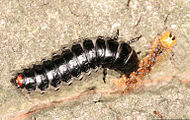Calosoma sycophanta
| Calosoma sycophanta | |
|---|---|

| |
| Scientific classification | |
| Kingdom: | |
| Phylum: | |
| Class: | |
| Order: | |
| Family: | |
| Genus: | |
| Species: | C. sycophanta
|
| Binomial name | |
| Calosoma sycophanta | |
| Synonyms | |
| |
The Calosoma sycophanta or forest caterpillar hunter is a ground beetle belonging to the family Carabidae.

Subspecies and varietas
- Calosoma sycophanta var. severum Chaudoir, 1850
- Calosoma sycophanta var. nigrocyaneum Letzner, 1850
- Calosoma sycophanta var. marginatum Letzner, 1850
- Calosoma sycophanta var. azureum Letzner, 1850
- Calosoma sycophanta var. purpureoaureum Letzner, 1850
- Calosoma sycophanta var. cupreum Letzner, 1850
- Callipara sycophanta rapax Motschoulsky, 1865
- Calosoma sycophanta var. smaragdinum Rossi, 1882
- Calosoma sycophanta var. habelmanni Schilsky, 1888
- Calosoma sycophanta var. purpuripenne Reitter, 1891
- Calosoma sycophanta ab. corvinum Heller, 1897
- Calosoma sycophanta ab. anthracinum Houlbert, 1907
- Calosoma sycophanta prasinum Lapouge, 1907
- Calosoma sycophanta ab. solinfectum Jänichen, 1914
- Calosoma sycophanta var. lapougei Breuning, 1927
- Calosoma (Callipara) sycophanta, Lapouge, 1932
- Calosoma sycophanta nigrosuturale Jaquet, 1930
- Calosoma sycophanta nigroaeneum Polentz, 1937
- Calosoma (Calosoma) sycophanta, Jeannel, 1940
- Calosoma (Calosoma) sycophanta, Gidaspow, 1959
- Calosoma (Calosoma) sycophanta, Deuve, 1997
- Calosoma (Calosoma) sycophanta, Erwin, 2007
Description
Calosoma sycophanta can reach a length of about 21–35 millimetres (0.83–1.38 in). This large ground beetle has characteristic metallic bright green elytra, while scutellum is metallic bluish. The head is black. These colors have iridescent shades that change (green, blue, bronze, copper, gold black) according to the direction and quality of light. Pronotum is transverse shaped, posteriorly sharply narrowed, wrinkled and punctured. Elytra are flattened with clearly visible punctures in the striae.[2]
Behavior
This ground beetle is a voracious consumer of caterpillars (especially Lymantria dispar, Thaumetopoea processionea, Thaumetopoea pityocampa and Euproctis chrysorrhoea) during both its larval stage and as an adult.[3][4][5][6]
As a predator the species has been researched for the effect of its predation upon the caterpillars with microsporidian pathogens, finding a preference for Vairimorpha disparis infected larva.[7]
Distribution
This species is native to Europe. It is present in most European countries, in the East Palearctic ecozone, in the Nearctic ecozone, in the Near East and in North Africa.[8] In 1905 it was imported to New England for control of the gypsy moth.[3]
Gallery
-
Adult of Calosoma sycophanta preying on a caterpillar of Lymantria dispar
-
Calosoma sycophanta, larva
-
Calosoma sycophanta larva eating a Lymantria dispar larva
-
Calosoma sycophanta, pupa
References
- ^ Biolib
- ^ a b Calosoma of the world
- ^ a b Ground Beetles, Susan Mahr, University of Wisconsin–Madison]
- ^ Hermann Burmeister Anatomical Observations upon the Larva of Calosoma sycophanta
- ^ Cookies on Invasive Species Compendium
- ^ Arthur V. Evans The Forest Caterpillar Hunter, Calosoma sycophanta
- ^ "Influence of the forest caterpillar hunter Calosoma sycophanta on the transmission of microsporidia in larvae of the gypsy moth Lymantria dispar". Retrieved 2013-05-13.
- ^ Fauna Europaea
![]() Media related to Calosoma sycophanta at Wikimedia Commons
Media related to Calosoma sycophanta at Wikimedia Commons
![]() Data related to Calosoma sycophanta at Wikispecies
Data related to Calosoma sycophanta at Wikispecies




